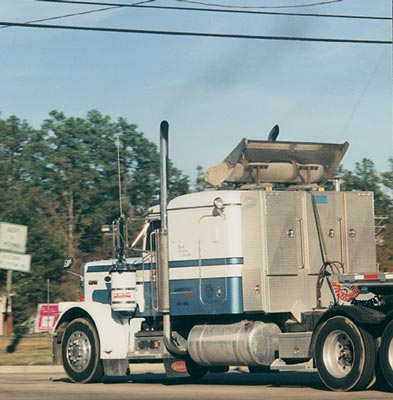Note to Truckers: Drink More Coffee
By David Schneider
Urea, among other things, may help to reduce the pollution spewing from diesel engines
Urea, among other things, may help to reduce the pollution spewing from diesel engines

DOI: 10.1511/2004.46.0
An all-too-common sight is a big diesel truck belching black smoke into the air. So it's a good thing that the 2004 model year ushered in some tougher U.S. standards for diesel emissions and that the regulations slated for the next few years will become even more restrictive. The designers of diesel engines have thus been hard at work trying to limit the various pollutants given off. One promising tactic uses, strangely enough, a small on-board supply of urea, the major component in some fertilizers and, of course, in urine.

David Schneider
The 2003 model cars, light trucks and SUVs with diesel engines were allowed to produce about a tenth of a gram of particulate matter for each mile driven, but the EPA standards for 2004 call for 0.02 gram or less. Particulate emissions from heavy-duty truck engines will be slashed too (in stages), from the current limit of 0.1 gram per horsepower-hour to one-tenth of that level, beginning with the 2007 models. Regulators are also clamping down on this form of pollution in Europe, where diesel-powered cars are expected soon to outsell those with gasoline engines. And some localities have begun waging a war against sooty diesel exhausts on their own. Last October, for example, the city of Tokyo began a mandatory program to retrofit older diesel trucks and buses with filters to control particulate emissions.
Several car makers, including Peugeot and Mercedes, are outfitting some of their new diesel models with such filters. This approach is not new—Mercedes sold diesel cars with particulate filters in California two decades ago but then abandoned this scheme because of technical difficulties in getting it to work reliably.
Some particulate filters use catalysts to oxidize the trapped carbon continuously, whereas others are designed to cycle up periodically to high temperatures, allowing the accumulated carbon to be quickly burned off. Engine designers can also limit the particulates created in the first place by lowering the fuel-to-air ratio in the combustion chamber of a diesel. But that may not be a particularly good answer to the problem, as Nigel Clark, an expert on alternative fuels, engines and emissions at West Virginia University, explains: "What you do to reduce particulate matter produces oxides of nitrogen and vice versa." Indeed, the invisible oxides of nitrogen (a combination of different gases, often labeled just NOx) are in some ways more of a problem than is the unsightly black smoke. Gasoline engines also produce NOx, but the catalytic converters under our cars remove these gases quite effectively. Unfortunately, such devices cannot be used for diesels, which contain too much oxygen in their exhaust streams for the catalysts to function properly.
Beginning in 2007, the EPA will begin phasing in standards that call for an order-of-magnitude reduction in NOx emissions from heavy-duty diesels. How engine makers will achieve that highly reduced level is unclear. One promising approach is called selective catalytic reduction. It works by combining the NOx-rich exhaust with ammonia. These gases combine to form nitrogen and water vapor, which can then be released harmlessly into the atmosphere. Of course, ammonia is a poisonous gas, so one doesn’t want too much of it leaking out of tailpipes. And having diesel cars and trucks zooming around with tanks of poison gas probably isn't a great idea either, which is why today’s prototypes are instead using liquid urea, which can be easily converted to ammonia on board the vehicle.
Europe seems poised to adopt this technology, which would require truckers to fill up auxiliary tanks (about 5 percent of the size of their fuel tanks) with a urea-water solution. Policy makers in the United States are, however, more hesitant to pursue this approach, which they regard as being difficult to implement (there being not much of a urea-distribution network in place) as well as difficult to police (there being no clear incentive for drivers to top up their urea tanks when they refuel). But maybe the regulators are selling truckers short. Drivers of big rigs probably care about problems with air quality as much as the next person, and some might well welcome the opportunity to contribute personally to the solution.—David Schneider
Click "American Scientist" to access home page
American Scientist Comments and Discussion
To discuss our articles or comment on them, please share them and tag American Scientist on social media platforms. Here are links to our profiles on Twitter, Facebook, and LinkedIn.
If we re-share your post, we will moderate comments/discussion following our comments policy.